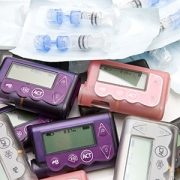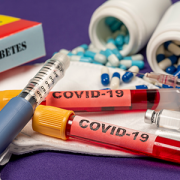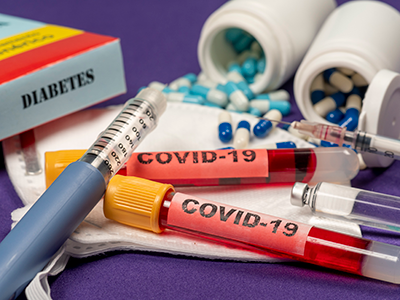
Researchers have learned a lot about COVID-19 over the past year and are continuing to learn and study more about this infection caused by the SARS-CoV-2 virus. There have been many questions about whether COVID-19 affects people with diabetes differently than those without and why this might occur.
Diabetes experts, like Brynn Marks, M.D., M.S.H.P.Ed., endocrinologist at Children’s National Hospital, have been studying the relationship between COVID-19 and diabetes, especially in the pediatric population. Dr. Marks tells us more about what we know so far and further research that needs to be done when it comes to COVID-19 and diabetes.
1. What do we know about COVID-19 and its effect on people with known diabetes?
The Centers for Disease Control and Prevention (CDC) currently lists type 2 diabetes (T2D) as a high risk condition for severe illness related to COVID-19 infection, while stating that adults with type 1 diabetes (T1D) might be at increased risk. A recent study from Vanderbilt University found that people with T1D and T2D were at approximately equal risk for complications of COVID-19 infection. As compared to adults without diabetes, adults with T1D and T2D were 3-4 times more likely to be hospitalized and to have greater illness severity. Given these comparable risks, both the American Diabetes Association and the Juvenile Diabetes Research Foundation are lobbying for adults with T1D to be given the same level or priority for COVID-19 vaccines as adults with T2D.
However, as pediatricians, we all know to be wary of extrapolating adult data to pediatrics. Children are less likely to be infected with COVID-19 and if they are, the clinical course is typically mild. To date, there have not been any studies of the impact of COVID-19 on youth with known T2D. Our clinical experience at Children’s National Hospital and reports from international multicenter studies indicate that youth with T1D are not at increased risk for hospitalization from COVID-19 infection. However, paralleling ongoing disparities in T1D care, African Americans with known T1D and COVID-19 infection were more likely to be develop diabetic ketoacidosis (DKA) than their White counterparts.
With the increased use of diabetes technologies, including continuous glucose monitors, insulin pumps and automated insulin delivery systems, diabetes care lends itself well to telemedicine. Studies from Italy during the period of lockdown showed better glycemic control among youth with T1D. Further studies are needed to better understand the implications of telehealth on diabetes care, particularly among those in rural areas with limited access to care.

Diabetes experts, like Brynn Marks, M.D., M.S.H.P.Ed., endocrinologist at Children’s National Hospital, have been studying the relationship between COVID-19 and diabetes, especially in the pediatric population.
2. What do we know about the impact of the COVID-19 pandemic on children with newly diagnosed diabetes?
Nationwide studies from Italy and Germany over the first few months of the pandemic found no increase in the incidence of pediatric T1D during the COVID-19 pandemic as compared to the year before; in fact, the Italian study found that fewer children were diagnosed with T1D during the pandemic. However, many centers are seeing higher rates of DKA and more severe DKA at diagnosis during the pandemic, possibly due to decreased primary care visits and/or fears of contracting COVID-19 while seeking care.
To date, no studies have been published exploring the incidence of T2D in youth. A group from Children’s National, including myself, Myrto Flokas, M.D., Abby Meyers, M.D., and Elizabeth Estrada, M.D., from the Division of Endocrinology and Randi Streisand, Ph.D., C.D.C.E.S. and Maureen Monaghan, Ph.D., C.D.C.E.S., from the Department of Psychology and Behavioral Health, are gathering data to compare the incidence of T1D and T2D during the pandemic as compared to the year before.
3. Can COVID-19 cause diabetes to develop?
This has been area of great interest, but the jury is still out. The SARS-CoV-2 virus, which causes COVID-19 infection, binds the angiotensin-converting enzyme 2 (ACE2) receptor which is located in many tissues throughout the body, including the pancreas. SARS-CoV-2 has been shown to infect pancreatic tissue leading to impaired glucose stimulated insulin secretion. Although the SARS-CoV-2 virus could plausibly cause diabetes, assessment has been complicated by many confounders that could be contributing to hyperglycemia in addition to or rather than the virus itself. Stress-induced hyperglycemia from acute illness, the use of high dose steroids to treat COVID-19 infection, and the disproportionate rates of infection among those already at high risk for T2D, as well as weight gain due to changes in day-to-day life as a result of social distancing precautions are all likely contributing factors.












